
The Results are In!
When we launched our first ever community survey at the end of August, we weren’t really sure what to expect. This wasn’t an incentivized effort. There was no reward or promised airdrop. So we didn’t know if you’d respond.
But respond you did. In just over a three-week period ending 22 September, we received 226 respondents to the survey, each spending roughly 3 to 5 minutes to tell us a little about themselves, with many taking more time to leave comments.
Our ninjas have crunched the numbers and after removing 2 respondents who chose not to share their responses publicly, we arrive at a final number of 224 total respondents. And in our fine tradition of sharing, here are some of the top line findings of interest from the AmaZix Community Survey.
1. We have a youthful community
Millennials are a huge part of AmaZix, with a total of 132 respondents (58.9%), meaning almost 3out of 5, aged between 18 to 30 years old. This was not surprising for us, given the general propensity of the average crypto user to be from the same age group.
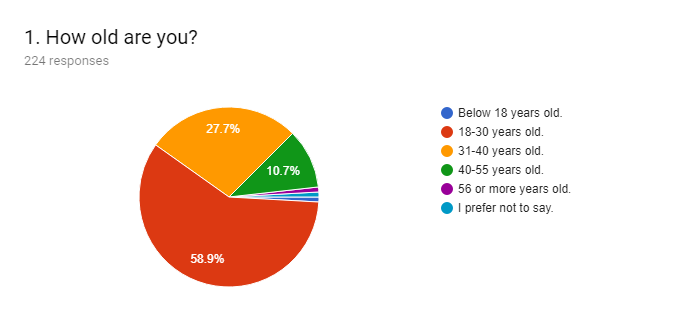
Generation X made a strong showing too, with just over a quarter of respondents (62 people, 27.7%) aged 31 to 40 years, hinting that the generation who saw the birth of the internet are very much in touch with fintech and blockchain.
1 in 10 respondents are middle aged, between 40–55 years old, showing us that there’s still significant interest from mature age groups.
Finally, we even had 2 respondents each claiming they were below 18 and above 55. Who says AmaZix isn’t for all ages?
2. We have a largely male community
While we do note that the overwhelming number of respondents were male (190 or 84.8%), we take heart than slightly over 1 in 10 of our community are female — it is a minority, but one that we feel is significant for a technology-oriented community, that is notoriously male-dominated.
We also had 6 people prefer not to disclose gender, while 2 identified differently.
3. Though concentrated in Europe and Asia, we are truly global
Asians formed the largest section of respondents, with 95 (42.4%) respondents from there, followed by Europeans, with 72 (32%) respondents. This is somewhat expected, given that other than our main language of English, we commonly see local threads for our communities in European and Asian languages.
Our diversity can be seen from 23 (10.3%) African respondents, 21 (9.4%) North Americans, 4 South Americans, 3 from the Pacific and Australasia, and 2 from the Middle East. 3 preferred not to say.

4. Many of us hold full-time crypto jobs
While more than half of respondents (124 or 55.4%) said that they considered crypto to be a hobby, we saw significant numbers of community members also saying that they were either full-time traders (41 or 18.3%), full-time professionals providing services (65 or 29%) or full-time professionals providing products (11 or 4.9%).
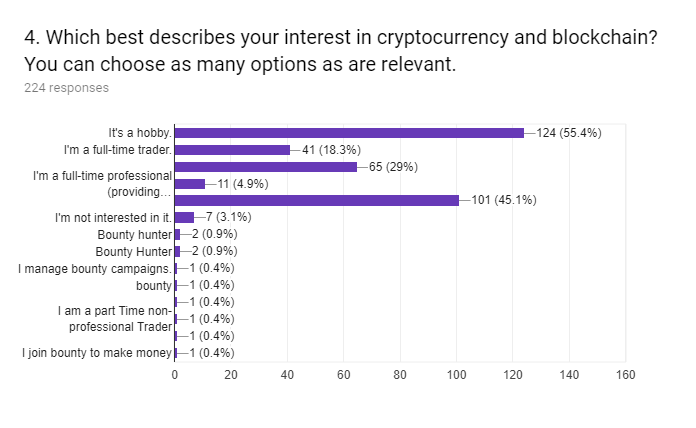
That’s a lot of our community members working in crypto and it tells us we’ve got pretty serious professionals in our midst.
Of course, we have to share that 7 people said they weren’t interested in crypto. We’re going to have to find out what their interest is in then!
5. Word of mouth is a powerful tool
When asked how they first learned about crypto, friends (106 or 47.3%), family (19 or 8.5%) and colleagues (9 or 4%) played a major role for most people.
News and media are still an important source that led them to crypto, however, with more than 1 in 4 people (61 or 27.2%) learning about crypto in the news. Everyone else got into crypto from work or from internet sources and social media.
6. We consider ourselves pretty knowledgeable in crypto and blockchain
When rating their own expertise in crypto and blockchain, a large majority of respondents (142 or 63.4%) said that “I’m quite knowledgeable but would like to learn more”. Add to that 18 or 8% who believed themselves to be experts, and 6 (2.7%) who thought they were extremely knowledgeable and we’ve got quite a crypto-able community!
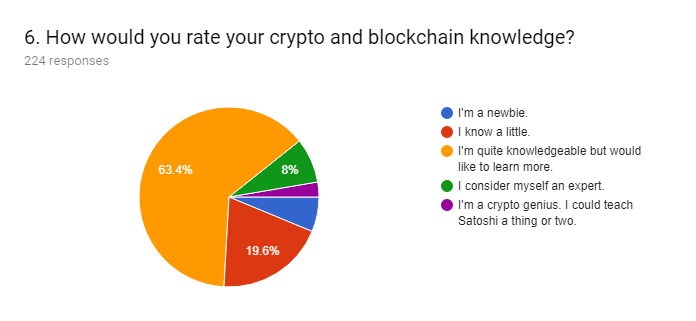
This tells us that our community is largely made out users who know what they’re doing and know their way around crypto!
On the other hand, 14 (6.3%) said that they were newbies, while 44 (19.6%) admitted they only knew a little about crypto.
7. Industry relevant developments, discussions and new tech attract us the most
Trying to gauge interest can be a tricky thing, but half of the respondents were “very interested” in new tech/products/solutions (113) and in bounties (111).
Of the totals who responded either “interested” or “very interested”, the numbers were:
- 186 for new tech/products/solutions
- 162 for industry news
- 161 for blockchain discussions
- 155 for bounties
- 154 for ICOs
- 77 for airdrops
New technology/products/solutions received the least “not interested” responses (6) while Airdrops received the most (74), showing a huge preference for the former and a marked disinterest in the latter.
8. We have faith in crypto’s promise of digital money
When asked about cryptocurrency’s future in 2050, 1 in every 3 respondents (74 or 33%) believed that “they will form the basis of a new payment system, much like Visa and Mastercard today, processing millions of payments”. We feel this is a huge endorsement of cryptocurrency as an everyday payment method, with blockchains being developed to process magnitudes of orders more transactions than today’s fastest traditional methods.
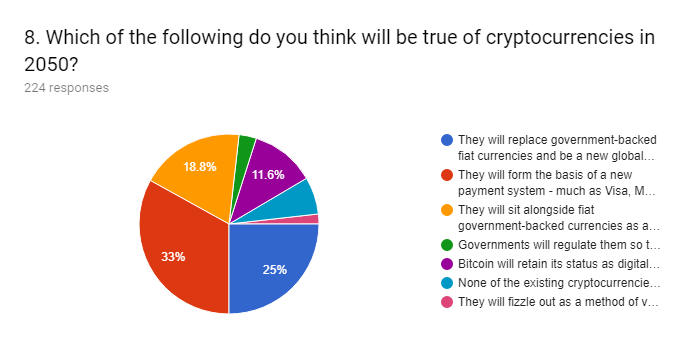
What’s also interesting is that 25% (56) of users go so far as to believe that crypto will eventually displace traditional money, a premise that rings true with many original idealists of Bitcoin and other crypto. A total of 42 respondents (18.8%) believe in a future of co-existence, where crypto and fiat are both used to transfer value between nations.
There were significant minorities, however. 26 (11.6%) believed that Bitcoin would retain its status as digital gold; we believe these are the hodlers, while 15 (6.7%) believe that none of the crypto we know today will exist, being replaced by better, newer versions.
Only a handful (7 or 3.1%) think that state regulations will push crypto underground, while 4 (1.8%) predict a worst-case scenario of crypto fizzling out as a method of payment.
9. We are big on forums, yet active on social media, especially Telegram
Almost every other respondent (110 or 49.1%) says that they first heard about AmaZix from Bitcointalk or other forums, while many others found us via social media (49 or 21.9%) or were referred to by others (41 or 18.3%). Google and other websites only accounted for 6 (2.7%) each.
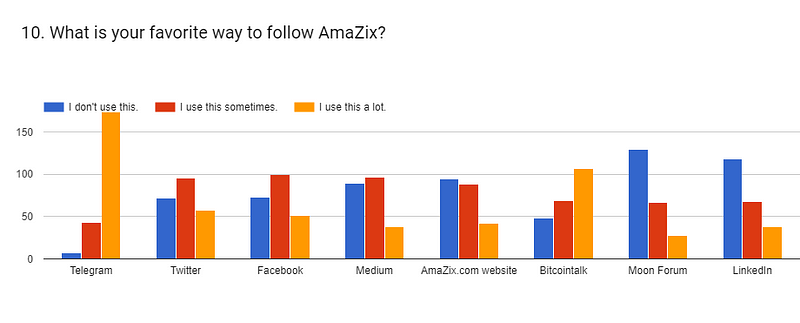
However, when it comes to keeping updated with AmaZix, Bitcointalk was only the 2nd favorite method (107 respondents). Telegram is the favorite way of following AmaZix, according to 174 respondents, while only a tiny number (7) don’t use Telegram at all. Other social media also had their fair share of being the most used platform: Twitter (57), Facebook (51), AmaZix website (42), LinkedIn and Medium (38 each). Despite being barely 2 months old, Moon Forum was also the favorite way for 28 respondents.
This tells us that forums are still a major gateway for new users, while social media and word-of-mouth play big roles. Telegram remains the single most used channel, and the one with the fewest who don’t use it.
10. We want more Partner/ICO features, and we’re following the market
It’s heartening to find out that even after so many partners and ICOs, we still want to know more! 71.4% (160) respondents chose Partner/ICO features as the content they’d like to see more from AmaZix.
Apparently, market and price analysis, which we don’t do, was also requested by a lot of users — 112 or 50% of you in fact! A fair number of respondents did want to read more industry opinions (103 or 46%) and personal community stories (87 or 38.8%), so that gives us some food for thought and we will look to tailor our content going forward to match your feedback.
And there you have it: a snapshot of the AmaZix community. Rest assured we will learn from the feedback and take all your responses seriously as we build bigger, and build better.
We wanted to get to know you a little better. And you made sure we did just that. Thank you.
By AmaZix Editorial on September 30, 2018.
Exported from Medium on January 30, 2020.
